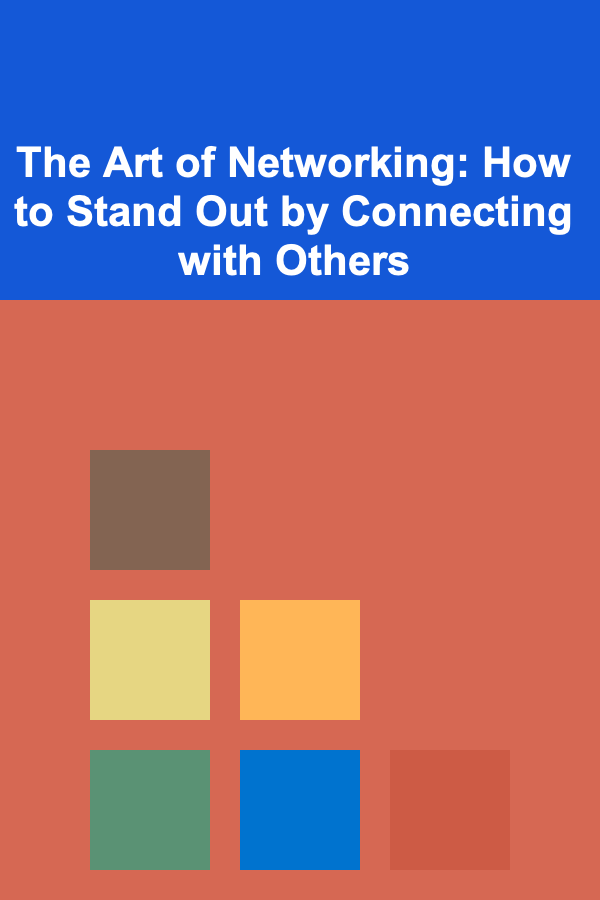
The Art of Networking: How to Stand Out by Connecting with Others
ebook include PDF & Audio bundle (Micro Guide)
$12.99$7.99
Limited Time Offer! Order within the next:

Networking is a fundamental aspect of professional and personal growth. Whether you're an entrepreneur, a job seeker, or simply someone looking to expand their horizons, the ability to connect with others meaningfully can unlock doors to countless opportunities. However, networking is not just about exchanging business cards or adding connections to LinkedIn. It's about building authentic relationships that offer mutual value.
In this actionable guide, we'll explore the art of networking---why it's crucial, how to master it, and how to stand out by creating connections that matter.
Understanding the Power of Networking
Networking is more than just an activity; it's an investment in long-term relationships that can provide value in unexpected ways. It goes beyond the transactional mindset of "what can I get from this person?" to a mindset focused on building authentic connections. Understanding the true power of networking will shift your perspective and allow you to approach it with the right intention.
Why Networking Matters:
- Opportunities: Many opportunities, whether job offers, partnerships, or collaborations, arise from the relationships you cultivate.
- Knowledge Sharing: Networking allows you to gain insights and advice from others who have more experience or expertise.
- Support and Guidance: A strong network provides a support system---people who can offer guidance when you're facing challenges or pursuing new ventures.
- Increased Visibility: Networking helps you get noticed, which can be essential in personal branding and career advancement.
To truly benefit from networking, it's essential to approach it with a genuine desire to learn from others, offer value, and grow together.
The Shift from Transactional to Relational Networking
Many people mistakenly view networking as a transaction: "If I give this person my time or resources, what will I get in return?" While it's important to consider the mutual benefits of networking, the most successful connections come from adopting a relational approach.
How to Make the Shift:
- Focus on Relationships, Not Transactions: Instead of thinking about how someone can help you, consider how you can help them. This mindset makes you more approachable and trustworthy.
- Offer Value First: Before asking for anything in return, look for ways to add value to others' lives. This could be through sharing useful information, making introductions, or offering your expertise.
- Listen More Than You Speak: People appreciate being heard. Ask open-ended questions, and take the time to listen actively to what others have to say. This creates a deeper, more meaningful connection.
- Long-Term Engagement: Networking is not a one-time event. Build relationships over time by staying in touch, offering help, and showing interest in others' endeavors.
By shifting your focus from transactional networking to relational networking, you set the foundation for sustainable and valuable connections.
The Art of Making a Memorable First Impression
In the world of networking, the first impression matters. You only have a few moments to make an impact, and how you present yourself can leave a lasting impression. Whether you're meeting someone at a conference, event, or even in an online setting, your ability to engage with others effectively is crucial.
Key Strategies to Make a Memorable First Impression:
- Be Confident but Approachable: People are naturally drawn to those who exude confidence without being arrogant. Smile, make eye contact, and engage in open body language. This creates an inviting atmosphere.
- Prepare Your Introduction: Have a brief but impactful way to introduce yourself. It should be clear and concise while highlighting something memorable about you---whether it's your professional expertise, passions, or what excites you about the networking opportunity.
- Show Genuine Interest in Others: Ask thoughtful questions and engage in the conversation. Showing curiosity about someone else's experiences or challenges demonstrates respect for their journey and opens the door to deeper conversations.
- Be Mindful of Your Body Language: Non-verbal cues play a significant role in networking. Positive body language, like nodding in agreement or maintaining an open stance, reinforces your message and builds trust.
The first impression sets the tone for the relationship. If you can engage meaningfully in the first few minutes, you increase the likelihood of building a long-term connection.
Leveraging Social Media for Networking
In today's digital age, social media has become an essential tool for networking. Platforms like LinkedIn, Twitter, and even Instagram can provide opportunities to connect with like-minded individuals, industry experts, and potential collaborators. However, using social media for networking requires a thoughtful approach.
Tips for Networking on Social Media:
- Optimize Your Profiles: Before reaching out to anyone, ensure your social media profiles are polished and professional. Your LinkedIn profile, for instance, should clearly reflect your expertise, accomplishments, and aspirations.
- Engage in Meaningful Conversations: Rather than simply adding people or liking posts, engage in conversations. Comment thoughtfully on posts, share relevant content, or ask questions to start a dialogue.
- Join Relevant Groups and Communities: Many platforms offer niche groups where professionals gather to share insights. Joining these groups allows you to engage with others who share similar interests or goals.
- Be Authentic in Your Interactions: Social media can sometimes feel impersonal, so aim to be genuine in your interactions. Personalize your messages when reaching out, and focus on building a connection rather than immediately asking for favors.
Social media can be an invaluable networking tool if used strategically. It's not just about expanding your reach---it's about creating meaningful relationships with people who resonate with your interests, goals, and values.
The Follow-Up: Turning a Meeting into a Relationship
After you've made an initial connection, it's important to follow up in a thoughtful and timely manner. This is where many people falter. A successful follow-up can transform a fleeting interaction into a meaningful relationship.
How to Follow Up Effectively:
- Be Prompt: Don't wait weeks to follow up. Send a message or email within 24-48 hours after your initial meeting while the interaction is still fresh.
- Personalize Your Message: Mention something specific from your conversation to remind the person who you are and show that you paid attention. Personalization shows that you're genuinely interested in continuing the relationship.
- Offer Value: When following up, think about how you can offer value. Maybe you have an article they might find useful or a connection that could help them with a project. This reinforces your commitment to the relationship.
- Be Patient but Consistent: Don't be discouraged if the other person doesn't respond immediately. People are busy, and sometimes a gentle nudge or a follow-up a few weeks later can remind them of the conversation you had.
The follow-up is where many relationships either thrive or wither. Make sure your follow-up is thoughtful, personalized, and shows a genuine interest in continuing the relationship.
Building a Network That's Diverse and Supportive
While it's tempting to network with people who are similar to you or share your interests, the most powerful networks are often diverse. A diverse network includes individuals from different backgrounds, industries, and perspectives, offering a broader range of insights and opportunities.
How to Build a Diverse Network:
- Seek Out Different Perspectives: Attend events or join groups outside of your usual industry or interest group. This introduces you to individuals who can offer fresh perspectives and ideas.
- Engage in Cross-Disciplinary Collaboration: Sometimes the most innovative ideas emerge when people from different fields collaborate. Look for opportunities to network with people from different industries or professions.
- Prioritize Inclusivity and Respect: Be respectful of others' experiences and viewpoints, especially when they differ from your own. A diverse network thrives in an environment where everyone feels valued and heard.
By intentionally building a diverse network, you expand your potential for growth and create an environment where everyone's strengths are celebrated.
Networking with Intention
Effective networking requires intentionality. Instead of trying to connect with as many people as possible, focus on building relationships with people who align with your goals, values, and aspirations. Quality over quantity is key in building a meaningful network.
How to Network with Intention:
- Set Clear Networking Goals: Understand what you want to achieve through networking. Are you looking for a mentor, business partner, or job opportunity? Having clear goals helps you target your efforts.
- Be Selective with Your Connections: While it's great to expand your network, it's more important to make connections that are aligned with your values and goals. Don't be afraid to say no to connections that don't serve your long-term vision.
- Be Consistent in Nurturing Relationships: Networking isn't a one-time event; it's an ongoing process. Be intentional about staying in touch, whether through occasional check-ins, offering help, or sharing resources.
Intentional networking ensures that the connections you make will contribute to your personal and professional growth in meaningful ways.
Conclusion
The art of networking isn't about collecting as many business cards or connections as possible---it's about creating lasting relationships built on trust, mutual value, and genuine interest. By shifting your mindset from transactional to relational networking, you can build a network that not only supports your goals but also helps you grow as an individual.
Networking is an ongoing process, and by practicing the strategies outlined in this guide, you can stand out by connecting with others in a meaningful and impactful way.
Reading More From Our Other Websites
- [Home Holiday Decoration 101] How to Create a Magical Holiday Atmosphere with Fairy Lights
- [Home Budget 101] How to Save on Monthly Home Expenses with Simple Tweaks
- [Personal Investment 101] How to Invest in Index Funds for Passive Income
- [Survival Kit 101] Building Your Emergency Supplies Kit: What to Include for Maximum Safety
- [Personal Care Tips 101] How to Choose Brow Gel for Every Brow Style and Trend
- [Organization Tip 101] How to Create a "Use First" Bin for Expiring Items
- [Personal Investment 101] How to Create a Passive Income Stream by Licensing Deep Learning Algorithms
- [Rock Climbing Tip 101] Choosing the Perfect Climbing Shoes: A Comprehensive Indoor Climber's Checklist
- [Organization Tip 101] How to Utilize Nooks and Crannies for Extra Storage
- [Home Storage Solution 101] How to Organize Kitchen Cabinets for Easy Access and Efficiency

How to Avoid Common Meeting Preparation Mistakes with a Checklist
Read More
How to Host a Family Olympics Day in Your Backyard
Read More
Strategic Leadership: The Role of a Chief Operating Officer
Read More
How To Use Social Media for Customer Advocacy
Read More
How to Meal Plan Around Leftovers: Weekly Recipe Ideas
Read More
10 Tips for Identifying Cloud Types and Predicting Weather
Read MoreOther Products

How to Avoid Common Meeting Preparation Mistakes with a Checklist
Read More
How to Host a Family Olympics Day in Your Backyard
Read More
Strategic Leadership: The Role of a Chief Operating Officer
Read More
How To Use Social Media for Customer Advocacy
Read More
How to Meal Plan Around Leftovers: Weekly Recipe Ideas
Read More